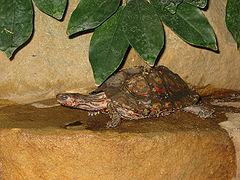From Wikipedia, the free encyclopedia
Geoemydidae (formerly known as Bataguridae) is the largest and most diverse family[citation needed] in the order Testudines (turtles) with about 70 species. It includes the Eurasian pond and river turtles and Neotropical wood turtles.Characteristics
Geoemydidae are turtles of various sizes (from about 10 to 80 cm in length) with often a high degree of sexual dimorphism. They usually have webbed toes, and the pelvic girdle articulates with the plastron flexibly. The neck is drawn back vertically. The carapace has 24 marginal scutes. The plastron is composed of 12 scutes and has no mesoplastron, the pectoral and abdominal scutes contact the marginal scutes.
Some other features include a single articulation between the fifth and sixth cervical vertebra, the lack of hyomandibular branch of the facial nerve and an epipterygoid bone in the skull.
[edit] Ecology
Geoemydidae live in tropics and subtropics of Asia, Europe and North Africa, the only genus in Central and South America is Rhinoclemmys. The habitats include freshwater ecosystems, coastal marine areas and tropical forests. Most of them are herbivorous, but there are also some omnivorous and carnivorous species. By mating the males are usually much more active than females. A relatively small number of eggs per clutch is common, produced several times a year. Some species have temperature-dependent sex determination system while others possess different sex chromosomes.
About 70% of the extant species have been reported to be in endangered or vulnerable condition.
[edit] Systematics and evolution
Traditional systematics placed the geoemydids to the family Emydidae as the subfamily Batagurinae. In the 1980s the subfamily was elevated to the family status and renamed to Geoemydidae according to the ICZN rules.
The majority of fossil and molecular data support their close relationship to the family Testudinidae.
The intra-familial taxonomy is not well established yet, due to the large number and diversity of species. The family is usually divided into two subfamilies and 22 to 27 genera. The division into subfamilies is currently disputed by some scientists.[citation needed] Several species are known to give viable hybrids, which makes the systematics even more complicated.
Geoemydidae (formerly known as Bataguridae) is the largest and most diverse family[citation needed] in the order Testudines (turtles) with about 70 species. It includes the Eurasian pond and river turtles and Neotropical wood turtles.Characteristics
Geoemydidae are turtles of various sizes (from about 10 to 80 cm in length) with often a high degree of sexual dimorphism. They usually have webbed toes, and the pelvic girdle articulates with the plastron flexibly. The neck is drawn back vertically. The carapace has 24 marginal scutes. The plastron is composed of 12 scutes and has no mesoplastron, the pectoral and abdominal scutes contact the marginal scutes.
Some other features include a single articulation between the fifth and sixth cervical vertebra, the lack of hyomandibular branch of the facial nerve and an epipterygoid bone in the skull.
[edit] Ecology
Geoemydidae live in tropics and subtropics of Asia, Europe and North Africa, the only genus in Central and South America is Rhinoclemmys. The habitats include freshwater ecosystems, coastal marine areas and tropical forests. Most of them are herbivorous, but there are also some omnivorous and carnivorous species. By mating the males are usually much more active than females. A relatively small number of eggs per clutch is common, produced several times a year. Some species have temperature-dependent sex determination system while others possess different sex chromosomes.
About 70% of the extant species have been reported to be in endangered or vulnerable condition.
[edit] Systematics and evolution
Traditional systematics placed the geoemydids to the family Emydidae as the subfamily Batagurinae. In the 1980s the subfamily was elevated to the family status and renamed to Geoemydidae according to the ICZN rules.
The majority of fossil and molecular data support their close relationship to the family Testudinidae.
The intra-familial taxonomy is not well established yet, due to the large number and diversity of species. The family is usually divided into two subfamilies and 22 to 27 genera. The division into subfamilies is currently disputed by some scientists.[citation needed] Several species are known to give viable hybrids, which makes the systematics even more complicated.


0 comments:
Post a Comment